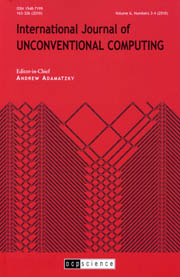 IJUC Home · Issue Contents · Editorial Board Subscription Info · Contributor Notes · Online Submissions · Call for Papers · Recommend
IJUC Home · Issue Contents · Editorial Board Subscription Info · Contributor Notes · Online Submissions · Call for Papers · Recommend
International Journal of Unconventional Computing
Editor-in-Chief: Andrew Adamatzky
ISSN: 1548-7199 (print)
ISSN: 1548-7202 (online)
80 pages/issue · 6″ x 9″
Issue Coverage: Volume 1 (2005) – Present
Abstracted and Indexed in:
Journal Citation Reports/Science Editions, Current Contents®/Engineering Computing and Technology, and Scopus.
Web of Science: Science Citation Index Expanded: Journal Impact Factor 1.17 / JCI 0.39
Aims and Scope
The International Journal of Unconventional Computing offers the opportunity for rapid publication of theoretical and experimental results in non-classical computing. Specific topics include but are not limited to:
- physics of computation (e.g. conservative logic, thermodynamics of computation, reversible computing, quantum computing, collision-based computing with solitons, optical logic)
- chemical computing (e.g. implementation of logical functions in chemical systems, image processing and pattern recognition in reaction-diffusion chemical systems and networks of chemical reactors)
- bio-molecular computing (e.g. conformation based, information processing in molecular arrays, molecular memory)
- cellular automata as models of massively parallel computing
- complexity (e.g. computational complexity of non-standard computer architectures; theory of amorphous computing; artificial chemistry)
- logics of unconventional computing (e.g. logical systems derived from space-time behavior of natural systems; non-classical logics; logical reasoning in physical, chemical and biological systems)
- smart actuators (e.g. molecular machines incorporating information processing, intelligent arrays of actuators)
- novel hardware systems (e.g. cellular automata VLSIs, functional neural chips)
- mechanical computing (e.g. micromechanical encryption, computing in nanomachines, physical limits to mechanical computation).
Both theoretical and experimental contributions are invited.
